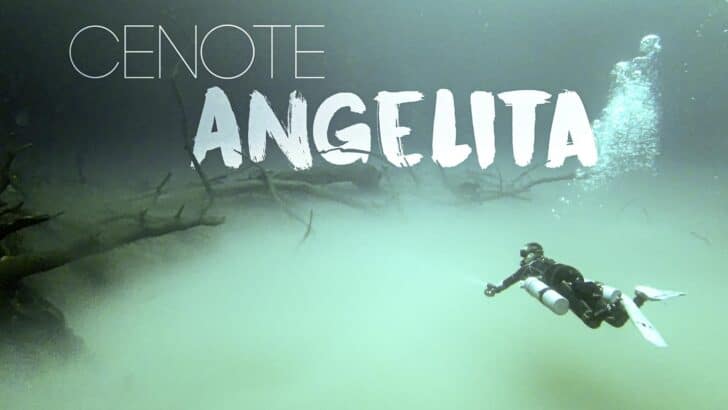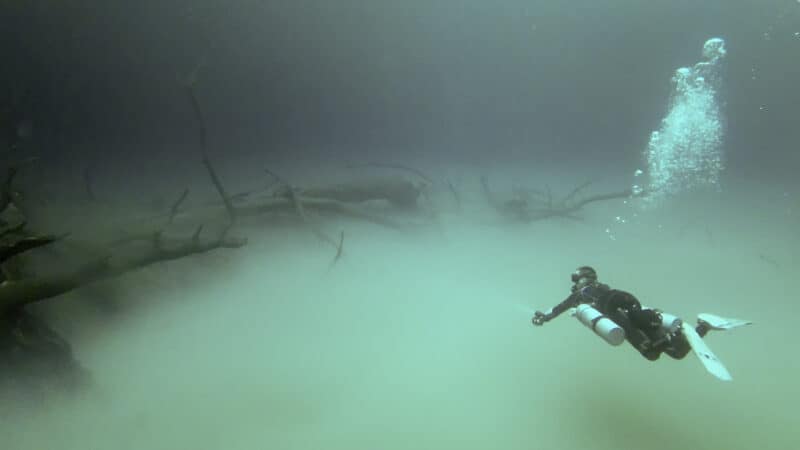Deep in the Mayan Jungles outside of Tulum Mexico, the dense green forest opens up revealing a 200-foot round hole that plunges down almost as deep as it is wide.
Inside this sinkhole, locally known as a cenote, is one of the most fascinating dive sites on the planet. Cenote Angelita is an absolute must for divers visiting the Riviera Maya.
How to get to Cenote Angelita
Located 15 minutes (15.6 km) south of Tulum town on Cancun – Chetumal/México HWY 307. From the highway, a narrow and bumpy dirt track takes you a few hundred meters into the thick Mayan jungle, bringing you to the open-top cenote known locally as Angelita.
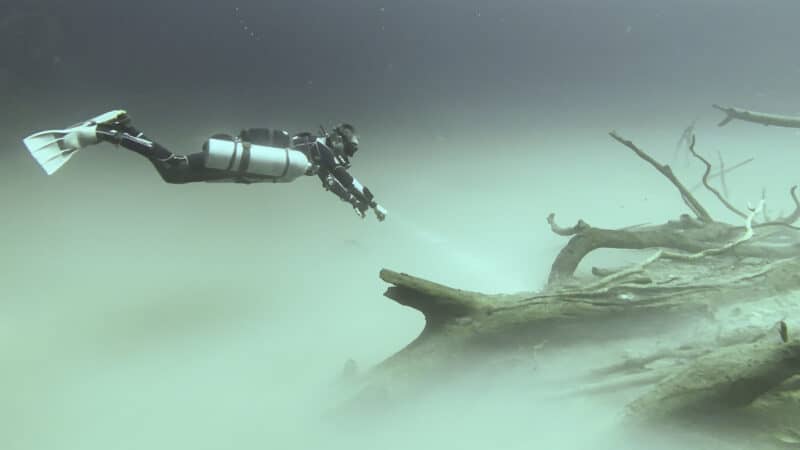
Diving Cenote Angelita
The main draw to Cenote Angelita can only be seen while diving this cenote. We dove here on our last trip to Playa del Carmen, and it quickly became one of our favorite cenotes to dive in Mexico.
Before jumping in, we geared up on the simple dive benches in the jungle. With our full gear on (less the fins), we marched a few minutes down the dirt trail leading to the cenote. With a giant stride off of the simple wooden dock, we were on our way to the Mayan Underworld.
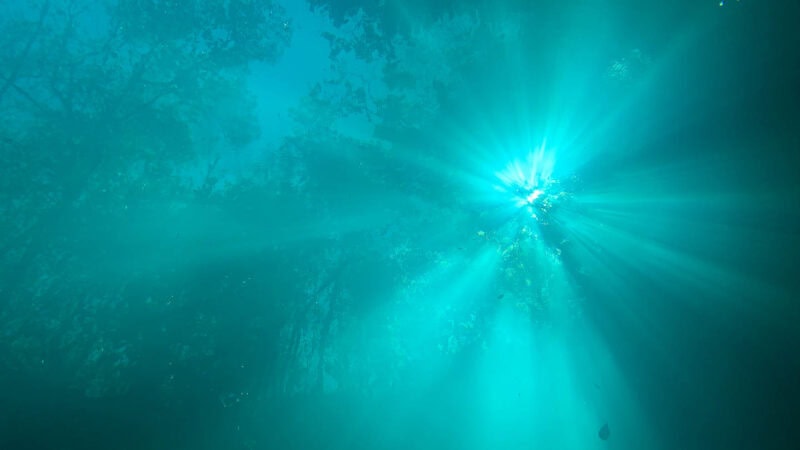
Into the Haze
As you begin to descend into the cenote, the water is hazy for the first 10-15 meters from organic material falling into the cenote from its lush surroundings. The Ancient Mayans believed cenotes were the entrance to the underworld – and the hazy start to this dive gives it that eerie feel from the beginning.
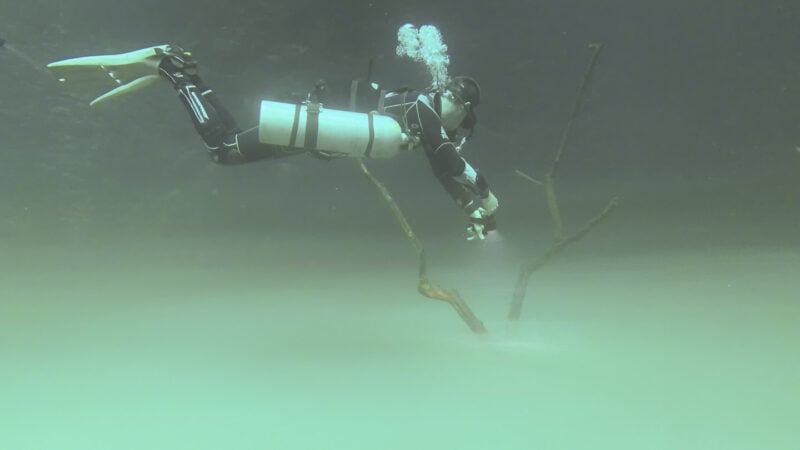
Swimming in the Clouds of Cenote Angelita
Deeper in the cenote, the haze starts to clear, and this is where the famous hydrogen sulfide layer of Cenote Angelita comes into focus. This right here – This is what you dive this cenote for. There is nothing else quite like it in the world.
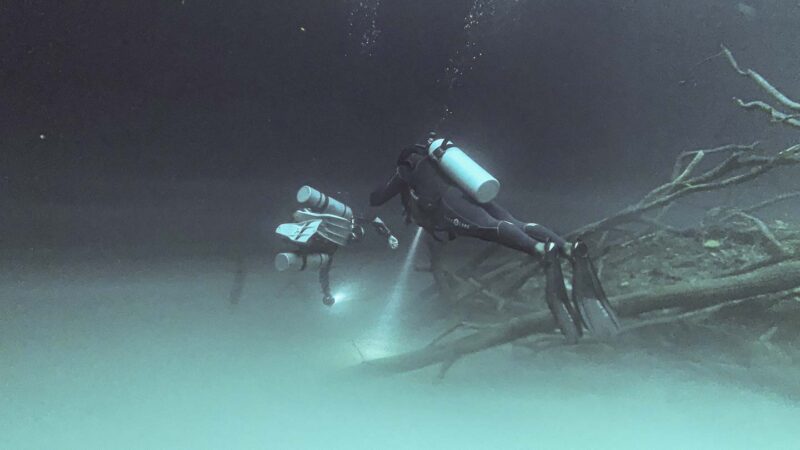
At 30m (99ft) sits a whispy, whimsical cloud of poisonous gas. It’s as eerie as it is magical. A 2-3+ Meter-thick cloud of hydrogen sulfide is suspended in Cenote Angelita.
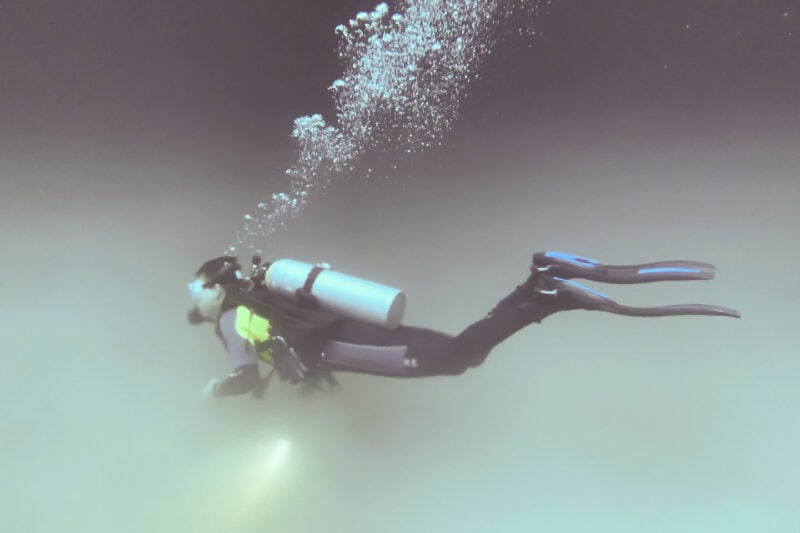
The cloud is formed from plant material falling into the cenote and breaking down releasing the hydrogen sulfide. At the cenote’s rim is a huge opening surrounded by lush jungle.
So, unlike other cenotes like the El Pit, which only have a thin wispy cloud, here in Cenote Angelita the cloud is dense and thick.
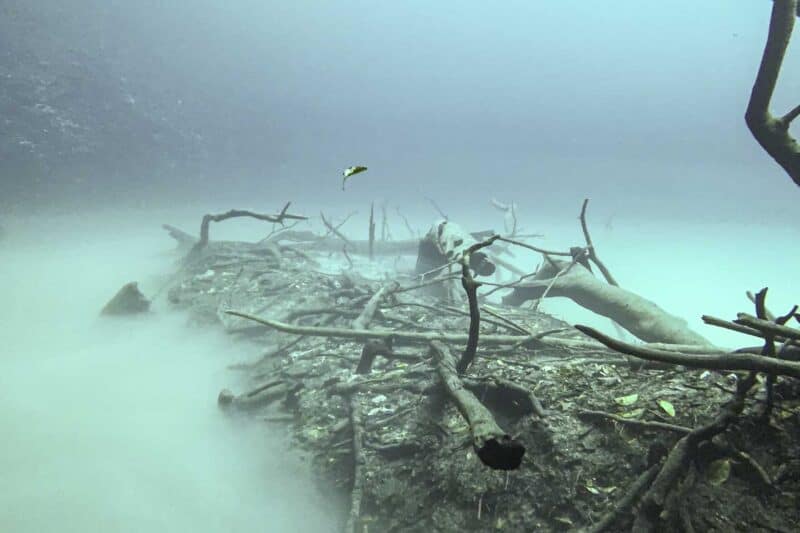
Cenote Angelita Talus Cone (debris mound) – 27 Meters (89 ft)
Rising out of the cloud are the rocks and rubble that used to cover the cenote before it collapsed, known as a Talus Cone – a fancy word for a debris mound.
The talus cone sits just above the cloud, almost like an island poking out of the mist. On top of the rocks are a handful of skeleton trees that complete the otherworldly scene.
One of the best moments of diving I have ever experienced is the time I spent swimming around the skeleton trees dipping in and out of the cloud.
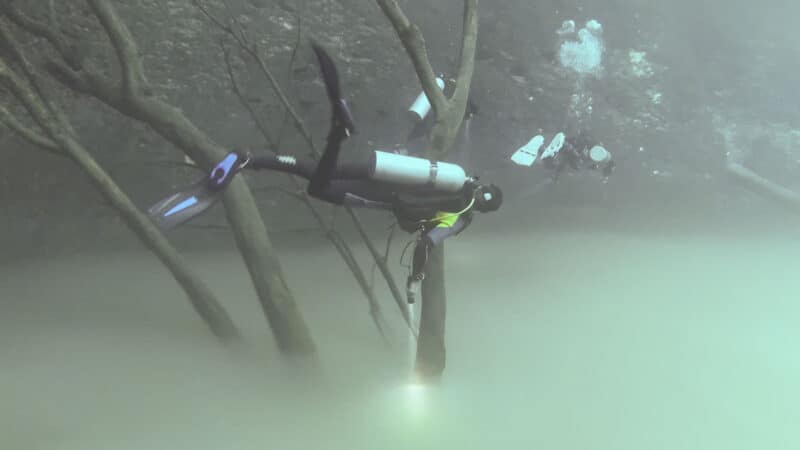
Besides being poisonous, hydrogen sulfide has a very sulfurous smell, which is pretty much like rotten eggs. It is safe to dive in and around the hydrogen sulfide since you are breathing compressed air from your dive tanks.
However, you can still smell the rotten egg smell through your regulator as you approach the cloud layer.
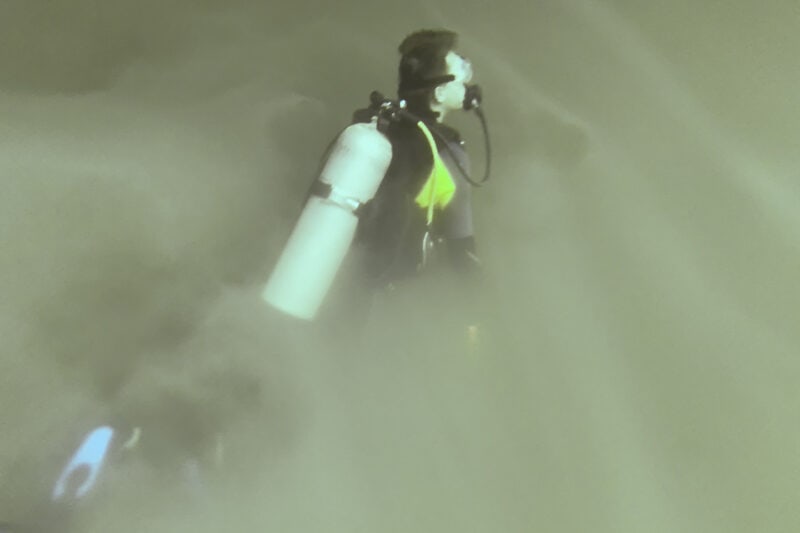
Under the Cloud
Beneath the hydrogen sulfide, the light is almost completely blocked by the thick cloud, making it nearly pitch black. If you plunge below the cloud, make sure your light is switched on and you keep an eye on your depths.
It is easy to get caught up in playing around in the misty cloud, and you can lose track of your depths. The bottom of the cloud starts to push the limits of recreational diving.
Deeper Haloline Layer
Due to its location further from the sea, the saltwater layer starts much deeper than other cenotes near Tulum. Under the cloud layer is where you will find the halocline where the salt and fresh water meet. However, the lack of light means it’s not a major draw to the cenote.
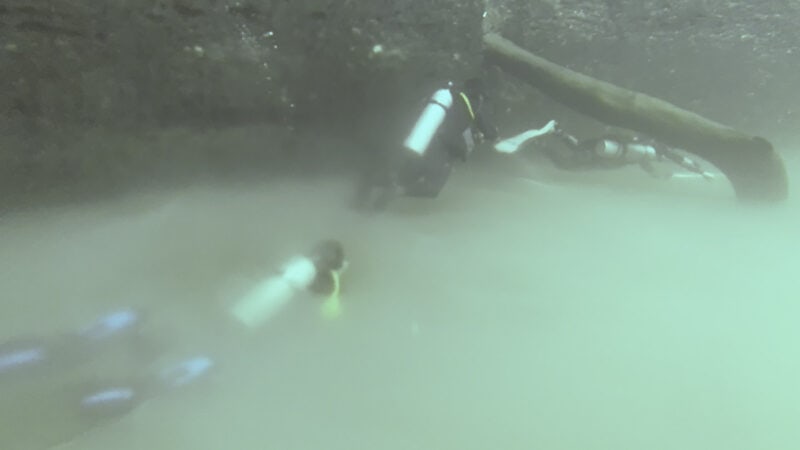
While there is conflicting information about the depth of the halocline, some dive maps have it at 42m, and others say it sits right under the hydrogen sulfide cloud. It would make sense that it is directly under the cloud, and the cloud essentially “sits” on top of the saltwater.
The photos I took after other divers in my group agitated the water around the cloud it gave a blurred look consistent with the Halocline.
What is a Halocline
The halocline is the depth where fresh and saltwater meet. Freshwater is less dense, so it will always be on top, and every cenote has a different halocline depth, which is related to how far the cenote is from the sea.
The further inland, generally, the deeper the halocline. In the case of Cenote Angelita, this cenote is further inland than many of the cenotes near Tulum and Playa, giving it a deeper halocline.
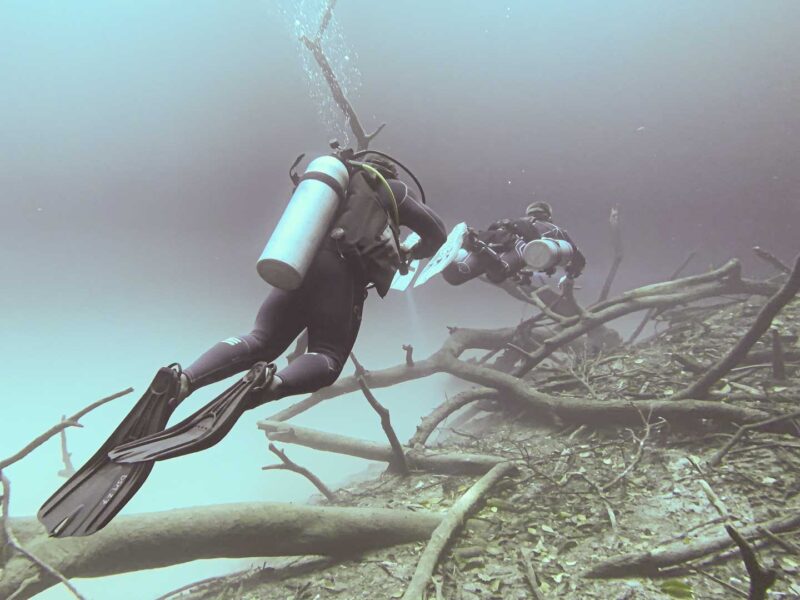
Enjoy this precious time on the bottom.
Most dive guides plan the dive around this feature, making a few laps around the cenote at the cloud layer until the group has reached pre-determined tank pressures before accending.
On the way back up
The dive isn’t over after the cloud. There are lots of things, big and small, to appreciate on the way up as well.
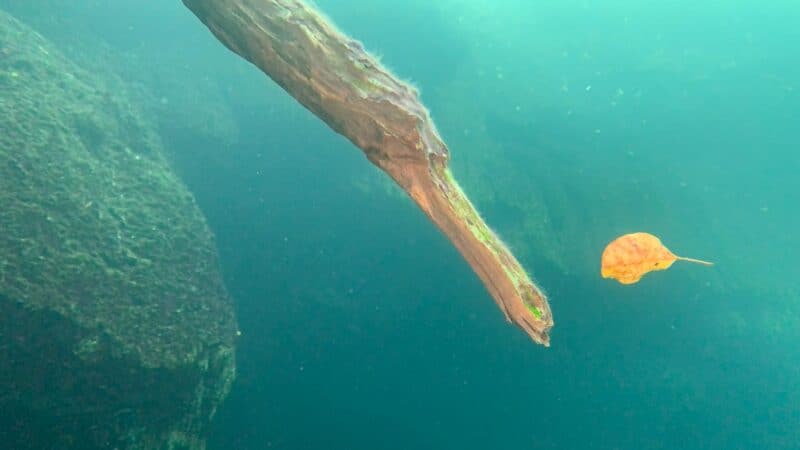
Leaves suspended in time
On the slow ascent back to the surface, keep an eye out for the fallen leaves that now seem stuck, suspended strangely still at different depths.
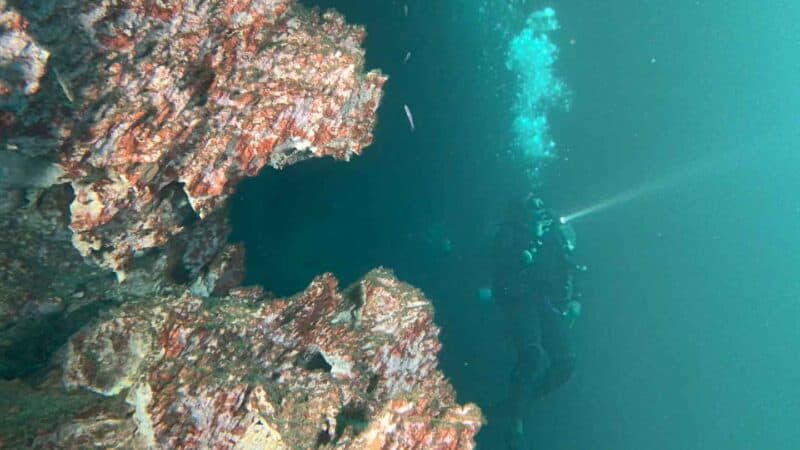
Cave Walls
A generally overlooked feature in this cenote is the tall vertical walls filled with all sorts of nooks and crannies to peer into. In places, the walls are covered in a pinkish-red color, which is likely some sort of algae.
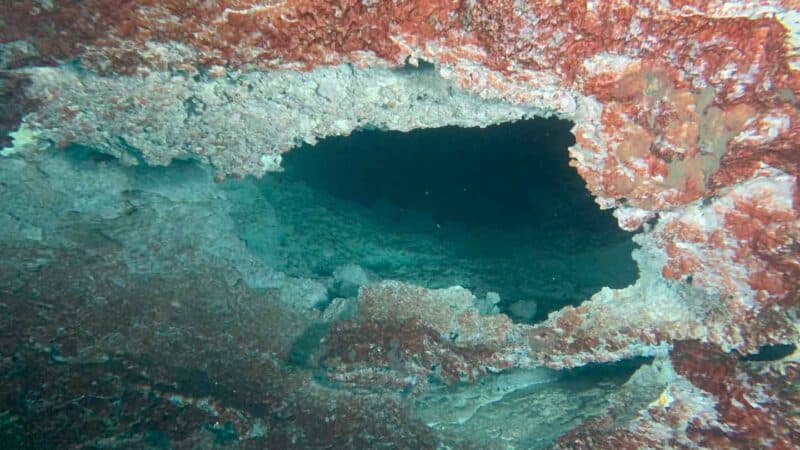
A few small openings to peer into as you make your ascent back to the surface. Since they are not hugely impressive, these features are done at the end to maximize your time at the bottom, admiring the otherworldly cloud layer.
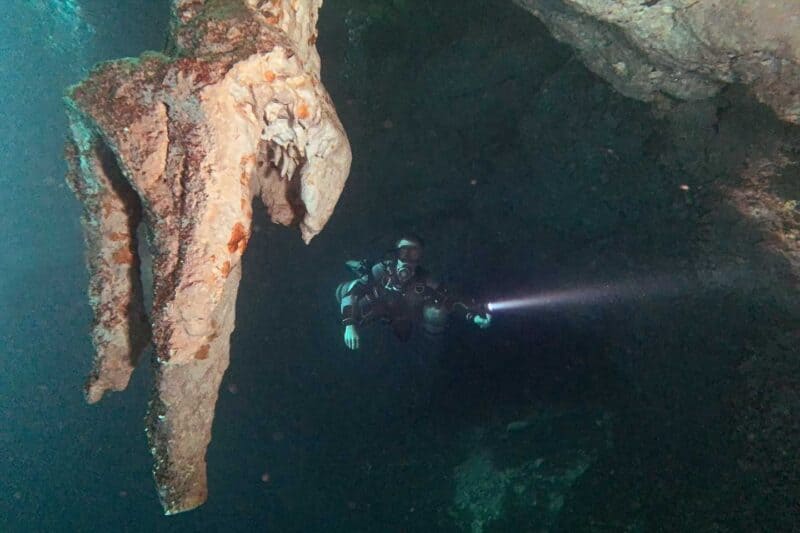
Massive Stalagtites
In a few places in the cenote, you can find large stalactites and other cave features that keep things interesting as you make your way back to the surface.
Details of diving Cenote Angelita
- Max Depth: 30 Meters is the general depth of most dives since it is pitch black under the Hydrogen Sulfide Layer. However, the bottom of the cenote is close to 60 meters deep.
- Recommended Certification level: Advanced Open Water – To see the cloud, you should be certified to dive to 30 Meters.
- Camera Fee: 500 Pesos is charged for a camera larger than a GoPro (generally)
Misleading information on the “Underground River” of Cenote Angelita
When researching Cenote Angelita online, you likely find many articles referencing an “Underground River” when referring to the hydrogen sulfide layer. However, the hydrogen sulfide layer has nothing to do with an underground river. It exists because material breaks down in this specific cenote and does not flow underground to other cenotes.
The authors of the other articles are using this terminology because they thought it visually looked like a river. This is extra confusing to people researching because many cenotes are connected through actual underground rivers in the fractured layers of limestone found all over the Yucatan Peninsula.
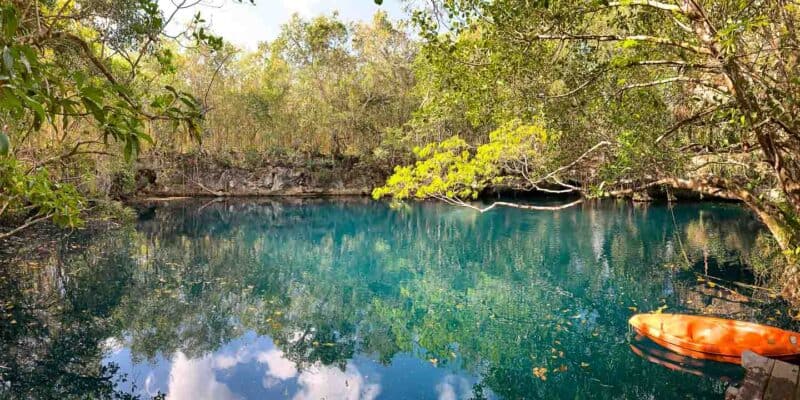
Snorkeling & Swimming in Angelita Cenote
Snorkeling is allowed in Cenote Angelita, but it tends to be more popular with divers. However, the 200-foot opening is surrounded by lush jungle and interesting rock formations, making it very interesting for swimmers and snorkelers.
Freediving in Cenote Angelita
Angelita has been attracting more freedivers with the increase in popularity of the sport. However, it’s best for experienced freedivers capable of reaching depths of 20-30 meters to see the cloud layer. The top 10-15 meters are a bit hazy and not a ton to see, so if you plan to free dive only to these depths, a different cenote might be a better option.
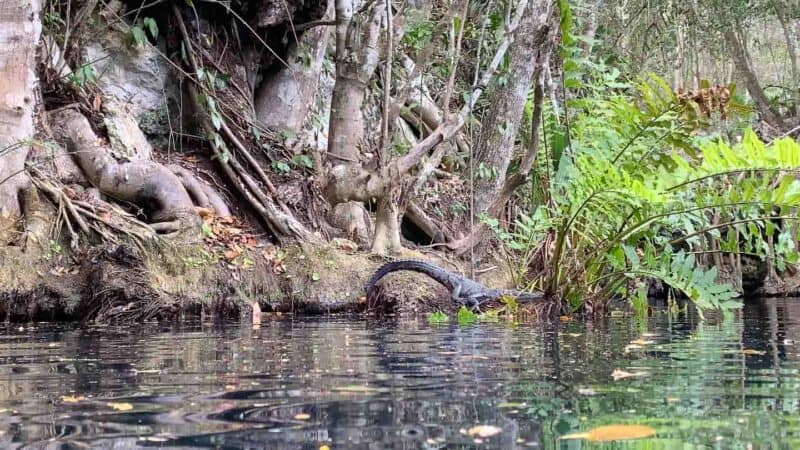
Find the Cenote’s Cayman
While finishing your dive or swimming at the surface, keep your eye out for the cenote’s resident small cayman (alligator). You can usually find this little guy soaking up some warm rays of sunshine on a log or rock near the water’s edge.
Don’t worry. He is still pretty small and nothing to worry about unless you are provoking it (please observe the cayman from a respectful distance).
Cenote Angelita FAQ:
Q: What is the nickname for Angelita?
A: In English, Angelita means little angel. The name comes from a cave formation found inside Cenote Angelita that resembles an angel.
Q: Where is Cenote Angelita?
A: This cenote is located about 15 minutes south of Tulum along Highway 307, not too far away from Kaan Luum.
Q: What is Cenote Angelita like?
A: Cenote Angelita is a large open-top cenote surrounded by jungle, and at 30 meters, you will find a unique hydrogen sulfide cloud which is the main draw to diving this cenote. Over the years, cenote Angelita has become a favorite among divers.
Q: How Deep is Cenote Angelita?
A: The bottom of the cenote Angelita is approximately 60 meters. However, most divers only go to depths of 30 or 40 meters.
Q: What is the visibility like in Angelita Cenote?
A: The first 10-15 meters are a bit hazy from the debris breaking down in the cenote. However, this produces an interesting light. below the hazy layer, it is clear until the cloud layer at 30 meters. The cloud layer is thick (nearly 3 meters) and dense. Below that, light doesn’t penetrate the hydrogen sulfide cloud. Therefore, it is dark.
Q: What Causes the Hydrogen Sulfide cloud in cenotes?
A: The breakdown of organic material results in a layer of hydrogen sulfide. Located 30 meters below the surface is a fascinating cloud layer made up of Hydrogen Sulfide. As debris and bacteria fall into the cenote, as they break down, they release hydrogen sulfide, which sits suspended in a cloudy layer halfway down this deep cenote.
Q: What is the cloud of Hydrogen Sulfide like?
A: Visually, the hydrogen sulfide layer has a spooky feel like mist on top of a swamp with a few dead tree branches poking out. The smell is similar to rotten eggs. When you are swimming through it you’ll see a stack of flat layers until it becomes a thick, dense gray cloud.
A: Does Cenote Angelita look like a swamp?
Q: When diving just above the cloud layer, it looks very much like a mist swamp. It is a fascinating effect.
Don’t Forget to Pin me for later!

2024 Isla Holbox Ultimate Guide – Must KNOW Travel Tips
Is Isla Holbox worth the trip? YES! Holbox Mexico is one of the best places in Mexico to visit. Skip Tulum! 2024 Complete Holbox guide with things to do in Holbox, best restaurants, where to stay, how to get to Holbox, and more.
5 Things To Know BEFORE Renting a Car in Cancun
Don’t rent a car in Cancun without reading this first! Cancun car rental guide: driving in Mexico tips, common scams, what to do if police pull you over, best rental car company, and more.
